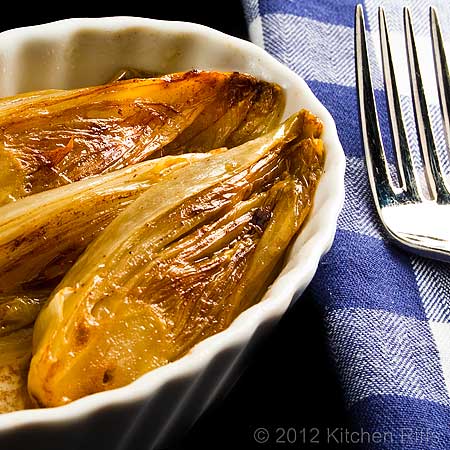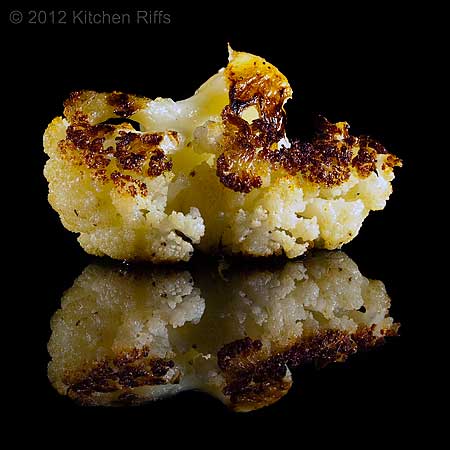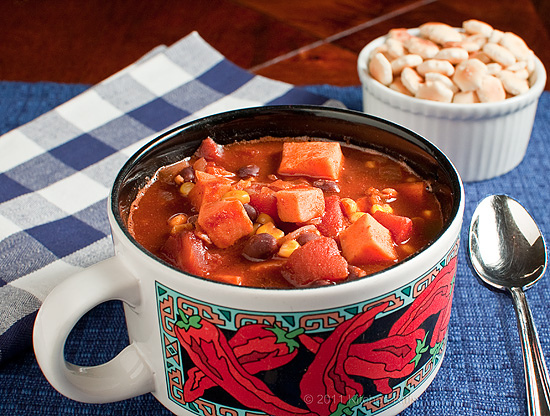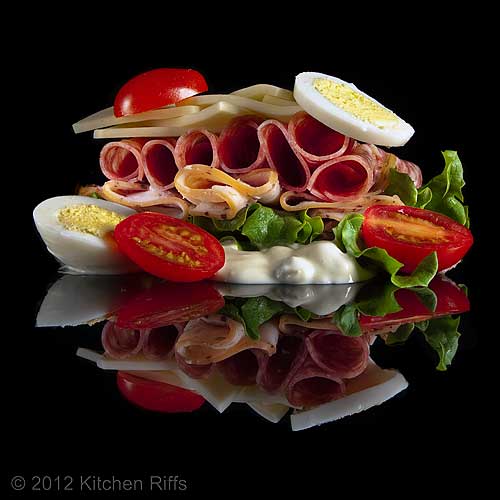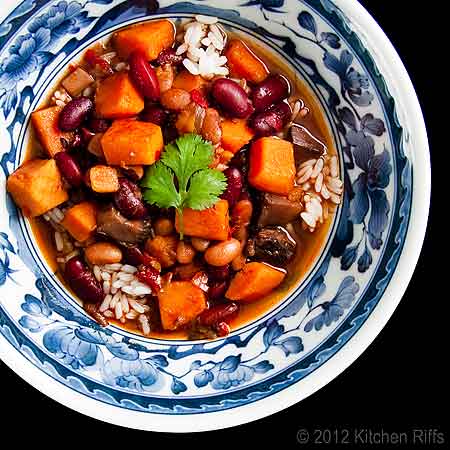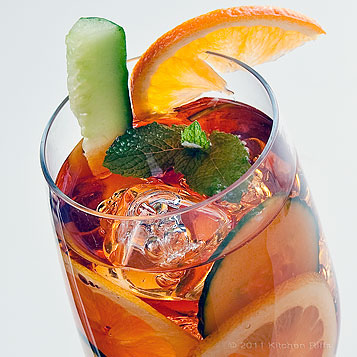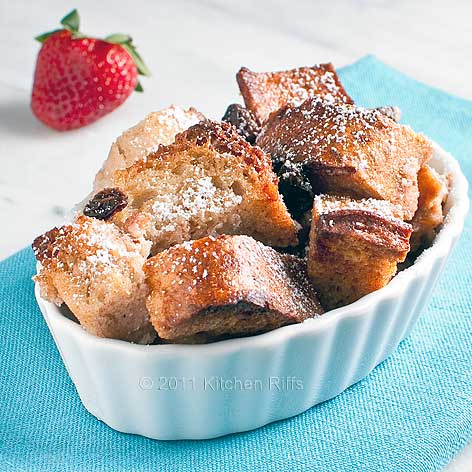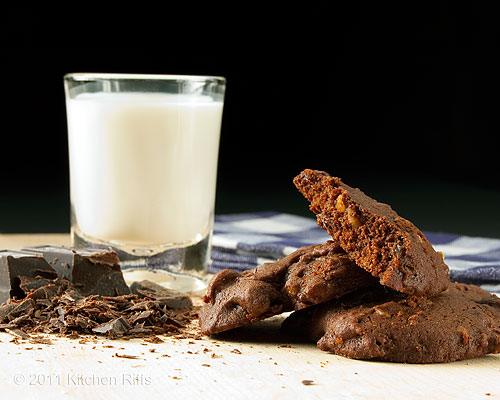Have you met John Griffin from Kitchen Riffs? Chances are that you haven’t but he’s someone you should get to know. I met him because he left a comment on OrgasmicChef and I repaid the compliment by visiting his blog. Over the past several months we’ve been exchanging comments on our blogs (as one does) and we’ve gotten to know each other a little better. I’ve also read every word on his About Me page.
John’s been interested in food since he was 12 years old. That was the year Julia Child started her first cooking show, The French Chef on WGBH in Boston. I lived in Maine at the time and John and I must be from the same era because I remember those shows too. The shows were all live and if she made an oops, she just wiped it up – she showed us how cooking is really done. Nothing airbrushed, nothing glamorized – just good food from good ingredients.
John’s mother was a decent cook but it was mostly meat and 3 veg and every family had to watch their pennies back then, especially where food was concerned. Sort of how it is now. Most food in the 60s wasn’t shipped across the world and if you lived in a northern state like I did, you lived on canned or frozen vegetables until you could get your garden growing come spring. John often talks about portion sizes and I can relate to his story that one can of peas would be enough for his family of 6 to share. We all lived well but we didn’t “supersize” anything way back then and everyone knew that Spam was meant to be eaten.
Kitchen Riffs started in December 2010 and I asked John if writing his blog has changed the way he cooks. “Because of the blog I’ve definitely cooked some foods that I never cooked before. A good example is Belgian Endive. I’ve blogged about it twice this year.” He’s also added more sweet potatoes to his monthly rotation. Too many people eat sweet potatoes as a Thanksgiving, Christmas or other holiday tradition but they’re fantastic to eat all year around.
John loves to cook and loves to innovate so he rarely cooks the same recipe twice – he can’t help but play with the ingredients or the method. (sound familiar?) When he’s preparing a recipe that he’s going to add to his blog, he cooks the recipe a couple of times to ensure that he’s got all the measurements right but if it’s a regular family meal for his wife and himself, it’s a pinch of this and a dash of that. He finds that blogging his recipes allows him to have a written record of really good food that he can get to in an instant. I have to admit that I’ve gone to the kitchen with the iPad on several occasions and made things from my own blog rather than dig out the recipe.
When I asked John what advice he’d give to a beginning food blogger he came up with two great pieces of advice. I’m going to let him tell you in his own words:
Two things. First, I’d suggest they read the series on how to start a food blog, on the Wandering Chopsticks blog. There’s a lot of good, basic information there that will get them up to speed quickly.
Second, I’d suggest they really figure out basic photography. We really do eat with our eyes to some degree, and nicely composed, well-lit photographs that are in focus are much better than those that lack those attributes. There are some really good photographers who write blogs – a few are professional photographers – but you don’t have to do as well as they do. Just learn the basics. One pretty helpful resource is the blog, Learn Food Photography. There are lots of other resources, but this one is free and has pretty good information. Just a little bit of knowledge helps most people’s photography quite a bit.
At holiday times or dinner parties John and his wife share the menu but regular daily cooking is done by him. His wife loves to bake and she makes killer mashed potatoes. Maybe she’ll do a guest post on John’s blog telling us how she makes them. When both are too tired to cook, they buy locally made pasta and sauces made by local restaurants. Classy fast food. In that family, whoever has done the cooking does the cleanup and no, he doesn’t ever wear an apron.
The reason he learned to cook is because he loves to eat – and eat food with tons of flavor. Nothing bland about this man at all. While he enjoys the process of cooking, he also looks forward to the photography and writing. He says that part of the challenge for him is looking at the colors, shape and texture of the ingredients and you’ll see that in all the photos. This chefs salad is a good illustration of that.
Do you have a favorite cookbook and if so, is it covered in spots and splashes, notes in the margins and always handy for reference?
Julia Child’s Mastering the Art of French Cooking is one of the greatest cookbooks every written. Every recipe works and tastes good. And most are pretty straightforward to make. And my copy is in tatters! I don’t often write notes in my cookbooks – I should. Again, that’s partially why I write the blog, to create notes for myself and to be able to share recipes when people ask how I made something.
James Beard’s Theory and Practice of Good Cooking taught me how to think about what makes a recipe work. He organized his book by cooking method – boiling, roasting, braising, etc. – rather than by type of recipe (soups, salads, fish, etc.). His cookbook got me thinking about recipes in a different way – how the technique makes the dish more so than the actual recipe. I have loads of other cookbooks that I’ll read and reread.
For the last couple of years I’ve been smitten by Fuschia Dunlop’s Land of Plenty and Revolutionary Chinese Cookbook. These cookbooks cover Sichuan and Hunan cooking, and it’s through reading Dunlop that I’ve really begun to understand Chinese cooking. The flavorings and techniques aren’t yet intuitive to me, and I doubt if they ever will be. But I can now go into the kitchen and whip up a pretty decent Chinese-style meal, using whatever I have on hand, without relying on recipes. But all of Julia Child’s cookbooks and Beard’s Theory and Practice are probably my most-read cookbooks.
One of the best dishes that John says he’s ever created is his Red-Braised Beans and Sweet Potatoes. Red-braising is a type of Chinese cooking where you cook your ingredients, usually meat, for a long time until they are tender and succulent and absorb the flavor of the braising liquid
What’s the best way to keep conversation going on your blog?
Really great question! Of course you have to get people to read your blog in the first place, and as someone with a relatively young blog, that’s where I’ve been putting a lot of attention. When I started blogging I didn’t even know the Foodie Photo Sites like Foodgawker or Tastespotting existed. Once I discovered them, it became my goal to get photos accepted by them on a regular basis – getting a photo on their sites always results in a nice little pop in readership. It’s ironic that I started doing this, because when I started the blog I assumed I’d have photos – every food blog has photos, right? – but that the recipes and the writing would be the focus. Well those are still what I’m personally most interested in, but I put a lot of effort into making my photos much better, and I’ve enjoyed becoming a better photographer.
Food photography is hard! You’d think it’s easy, because the subject is tasty and often colorful – except when you’re doing something brown or tan, like noodles. How do you make a noodle look good? You can, but you need to think about it – just plating it and taking pictures willy-nilly probably isn’t going to work.
Anything new coming up?
Starting next week I’ll begin a 4-part series of posts about summer cookout fare – Memorial Day in the US is coming up, and traditionally that’s the start of summer cookout season here. And this summer I’m going to be doing something completely new (for me), and do a weekly cocktail posts I’m going to call my Summer Sippin’ Series. I have been publishing cocktail posts, but usually only once a month. They’re actually some of my most popular posts. For example, my Pimm’s Cup post is my all-time most popular post and continues to draw a lot of traffic, mainly from Google searches.
When I asked John if he had any food heroes I nearly fell over when he said Stephane Lemagnen from ZenCanCook.com. I’ve been a Zen drooler for years, from way back when his website was pretty crap looking but the food was devine. You’ll find his maple bourbon ice cream on my cooking bucket list. John and I both love how Stephane handles flavors and combines ingredients plus he’s French, he’s wacky and he’s fun.
When asked if there was a food magazine that he couldn’t wait to read the minute it arrived, John said that he believes there’s much more energy and enthusiasm for food on the web, especially food blogs. The only downside is having to stroll through so many blogs to find the nuggets of gold where you can learn new methods, combinations and dishes. He does miss Gourmet magazine.
Any plans for changes to your website? Will your wife add some baking “guest posts” this year in the way that RufusGuide works with Greg and Katherine?
There are a couple of changes coming, mainly minor. I need to add some static content, primarily a recipe page so people can find things easier. And I’ll be adding an “about” page – although I have a profile page, it’s long on food memories, but short on details – like my name! When I started writing Kitchen Riffs, I didn’t think anyone would really care about who was doing the writing, just the content – but people want to know. And I plan to do a very slight page redesign. The question about my wife is a good one. She actually contributes to every post now! I’m a good writer, but she’s better; plus she’s a professional editor. And the kind of editing she does isn’t copy-editing – she’ll take authors’ manuscripts and do complete rewrites when necessary. So I always run every post past her – with that kind of resource in the house, I’d be crazy not to use her! Fortunately my posts don’t need much work (usually!), but anyone’s writing can stand to have someone help clarify and reorganize it when necessary. And she has contributed a post before, on Bread Pudding. But we’ve found it’s probably easier for her to make some of her specialties – she bakes all of the cookies on the blog, for example. Then I’ll write up the recipe in the post using her input, and as she edits she’ll add details and so forth if necessary. But having us both contribute posts is something I haven’t ruled out for the future.
Do you plan your posts ahead or cook something and then think it will be great for the blog?
All of my posts are planned ahead – although sometimes only by a few days! Part of the reason is I’ve come to learn that my photographs are better if I’ve thought them through ahead of time – before I make whatever it is that I’m going to write about. And I’d like to do more short series of posts – several over a 2 week period, like the Cinco de Mayo series – and that requires some planning. Sometimes I do cook something and think it’ll be great on the blog – after the fact! And with no opportunity to take pictures. So I’ll make it again, which I’d usually have to do anyway so I could figure out what the ingredient amounts need to be.
Finally can you share a recipe on your blog (or written out) that brings back great memories?
A nice example is the recipe for the Best Chocolate Drop Cookies Ever. These come from my great-grandmother, although Mrs K R added some improvements to the recipe. My mother used to bake this cookie every year at Christmas, and it’s always been one of my favorites. As a child I loved Christmas, partially for the usual reasons – all that loot! – but also because it was one of the few times of the year when we had some really great food, and lots of it. No Spam! Canned peas took a holiday! Cookies as far as the eye could see!
- 3½ squares (ounces) unsweetened melted chocolate (melt in microwave; see step 2 in Procedure)
- 1 cup raisins
- 1 cup chopped nuts (walnuts are particularly nice in this recipe)
- ½ cup butter
- 1 cup brown sugar (light brown is what we use)
- 1 egg
- ½ cup milk
- 1 teaspoon vanilla
- 1½ cups flour
- ½ teaspoon baking soda
- ½ teaspoon salt
- Preheat oven to 350 degrees Fahrenheit.
- Chop chocolate into bits, place in microwave-safe bowl. Heat on medium for 30 seconds; check to see if melted. If not, heat another 15 to 30 seconds, and check again. Continue until melted. Do not overheat! Let cool somewhat before you use it in step 7.
- Place raisins in saucepan and add just enough water to cover; place over medium heat; once water comes to a light boil, turn down heat and let raisins simmer while you mix other ingredients.
- Chop nuts.
- Cream butter using an electric mixer (a stand mixer is easier to use, but a portable mixer works too). When the butter is soft, mix in the following ingredients one at a time, mixing after each addition: brown sugar, egg, milk, and vanilla. Mix until well combined.
- Add chopped nuts and drained raisins. Mix.
- Add cooled chocolate, and mix again.
- In a separate bowl, measure flour, baking soda, and salt, and mix to incorporate. Then add to bowl containing chocolate mixture, and mix until well combined.
- Prepare baking sheet(s) by covering the baking surface with silicone mat(s) or parchment paper. Spoon dollops of cookie batter onto the sheet(s), making sure to leave enough space between dollops so the cookies can spread when baking.
- Bake for about 11 minutes or until done. What is done? When it’s baked through, but not dry. (If you’re not sure, lightly press the top of a cookie. If it’s done, the top should spring back.)
- Cool, then gobble them up.
